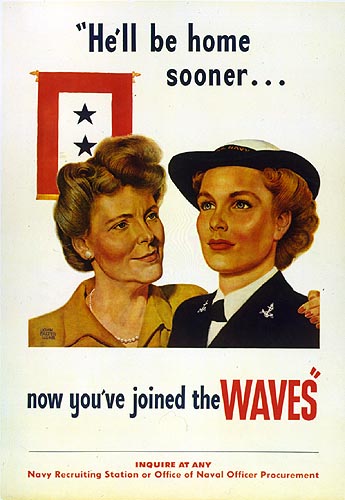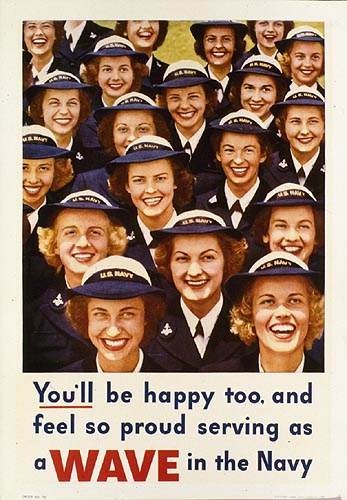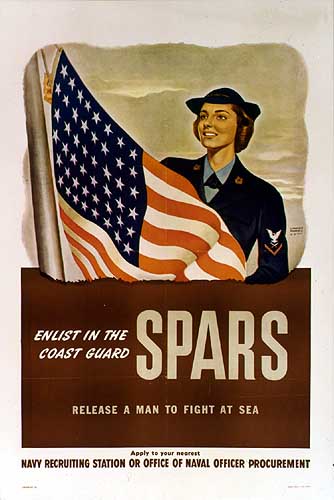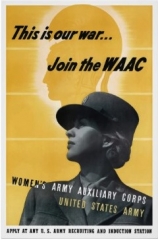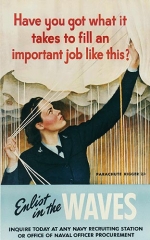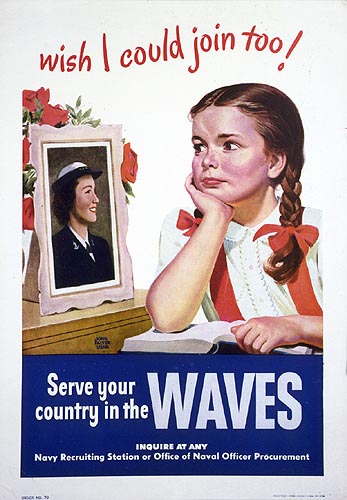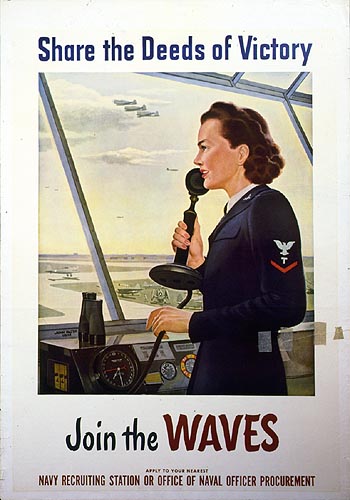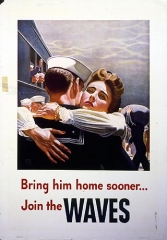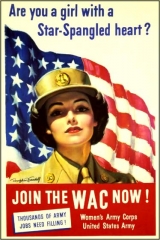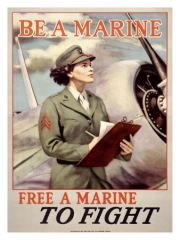Recruitment Posters
Posters were used extensively during World War II in a coordinated effort to win over the hearts and minds of American citizens. Posters came in a variety of sizes, from small table-top displays to roadside billboards. They were produced under the supervision of the Office of War Information, which coordinated with various organizations to get the message out quickly and effectively. A National Archives exhibition divided World War II poster output into two general themes: those that convey American strength and those that confront the viewer with the human and emotional costs of war.
Recruitment Posters
Poster Girls
Navy and Coast Guard posters had two functions. The images attempted to entice recruits, while also convincing fathers, mothers, husbands, and brothers that serving in the WAVES and SPARs was an honorable job for a young woman. In addition, the government was attempting to convince women, especially those who weren’t in the workforce, that moving into non-traditional work was not only appealing, but a duty.
Have you seen the WAVES propaganda?…It was everywhere. They did a really great job convincing the parents of America to let their daughters go…You couldn’t go down the street without seeing it. It was all over. They really blanketed the country to recruit.
American Strength
The OWI’s plan was straightforward:
These jobs will have to be glorified as a patriotic war service if American women are to be persuaded to take them and stick to them. Their importance to a nation engaged in total war must be convincingly presented.
An exhibit in the National Archives demonstrated two major themes emerged in World War II posters. Images of women were often used as emotional devices in those designed to convey the costs of war. But recruitment posters almost universally celebrated American strength and fortitude, including those featuring women. Patriotic colors of red, white and blue dominated, and national symbols or heroic-looking characters were common illustrations.
Victory is Ours
The most frequent message in military posters was to directly appeal to the women’s sense of patriotism.
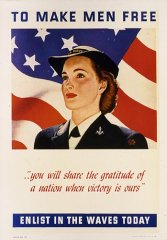
In this poster, the femininity of young woman (red lips, lightly rouged cheeks, neatly curled hair) is highlighted by the ray of light that shines on her from the poster’s left. A flag waves behind her, suggesting that her feminity is enhanced by her patriotism (volunteering to serve in the Navy).
SPARs Recruits
The Navy and the Coast Guard had the same goals (gaining female recruits), but their recruitment imagery differed. The majority of the WAVES posters were based on paintings by John Falter, but the SPARs used a variety of artists. While most of the WAVE posters used patriotic and bright colors, the SPARs posters often featured darker colors. such as olive green or brown alongside the patriotic symbol of the flag.
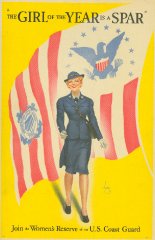
This SPARs recruitment poster was created by Antonio Vargas, who came to fame as an illustrator for Esquire magazine. Note the body-hugging uniform with an almost sheer skirt.
Let a Sailor Go to Sea
I saw so many posters, and a lot of the posters said, “Uncle Sam Wants You.’” Then I saw one that said something . . . about “let a sailor go to the sea.” And I thought, “Gosh, I’d like to do that. Let a sailor go to sea. I could do the work that he’s doing.” And that’s exactly how it turned out. I walked in to the office where I was a leave, liberty and watch yeoman, and I walked in and the sailor stood up, and he said, “Oh, you’re here at last.” And he left and I stayed. I met him later in Philadelphia, and he was assigned to a destroyer. That made my day. He was happy and I was pleased.
– Ali McLaughlin McConnell, World War II Navy WAVE
recruitment posters
Girls Next Door
Outdoor advertisers distributed a quarter of a million OWI billboard posters each month, while railroads rotated posters inside thirty-five thousand trains. Individual campaigns were usually on display only for a week or two. Posters were also used at recruitment stations.
There was war work and you were working at the shipyards and you could not quit. So that’s when I said, “I’m definitely going in the service.” And I went.
Navy Benefits
The Navy didn’t just appeal to women’s patriotism. It also attempted to lure recruits by emphasizing a key perk: women could serve at equal rank and receive equal pay to Navy and Coast Guard men. Many of the women interviewed for this project had worked at a defense plant before enlisting. They often found these jobs routine and boring, but they were also unable to quit because the work was necessary for the country’s military mobilization. Enlisting was the only way they could free themselves from the drudgery.
Women also escaped factory jobs because of dangers. Doris Mansfield Marquez was losing her hair because of the metal dust she was exposed to while working on a hand-operated grinder at Minneapolis Honeywell. She enlisted in the Navy rather than continue in that line of work.
A Great Opportunity
In this poster, the two young women stride confidently in front of the New York City skyline. They’re wearing the Navy white dress uniform and joining the WAVES is framed as a “great opportunity.”
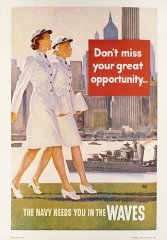
The poster illustrates how the Navy tried to shape group identity through the uniform. The two women walk in lockstep, their heads turned in the same direction looking toward New York City and the ships in the harbor. Each carries a white clutch purse and wears white oxfords with a short stacked heel and neatly tied bow.
The suggestion is that by joining the WAVES, a woman will be just like the smartly dressed young women in the recruitment poster, wearing fashionable uniforms (in this case dress white), and become part of the what WAVE Ali McLaughlin called a “refined” branch of the service.
Finding A Way
They had posters all over, you know. Of course, there was a recruiting office in Salem [Oregon]. And I trotted right down there to hear all about it. Because, as I told you, I always wanted to be a sailor. I was very unhappy because I was a girl and couldn’t join the Navy. Because I would have joined the Navy as soon as I could after getting out of high school. So, boy the minute I saw that I went down there and got all of my information . . . Some of the stores would even put posters in their windows. But that wasn’t why I joined, kid. The posters didn’t have to do that for me. I was there [laughs].
– Dotty Anderson McDowell, World War II Navy WAVE
recruitment posters
Emotional Appeal
The posters demonstrate how the Navy was in complete control of the image of the WAVES, from potential recruits to women serving
It was everywhere. It was on every poster. I was in high school at the time. I would have been in the WAVES earlier, but I didn’t graduate from high school until ’42. And I went to California thinking I would go to school at Berkeley and live with my sister . . . Of course in San Francisco, I saw nothing but Navy, Navy, Navy, Navy, Navy. And so I wanted to join the WAVES. I had two girlfriends join the Army, the Marines, but my mother said, “Well, you can remain a lady if you join the Navy.”
Bring Him Home
The Navy’s poster production unit’s output was varied. Images were derived from either photographs or paintings. Most of the images were created by John Falter, a painter and illustrator whose work was inspired by Norman Rockwell. Posters showed women at work in air traffic control towers, rigging parachutes or as a radio operator. Others showed women’s motivations for joining, such as a loved one was missing in action or the desire for a boyfriend to come home sooner.
Getting the Family’s Blessing
The WAVES posters not only appealed to a woman’s sense of duty, but also to a family’s sense of pride.
Most of my friends – you had to be twenty to go in. Your brothers could go in at eighteen. And so I had a lot of friends that spent their nineteenth year trying to persuade the old man to sign for you. “What about Rosie O’Donnell’s father letting her join the Marines and you don’t mean to say the O’Donnells have more moxie than the Dermodys?!” It was a campaign.
– Josette Dermody Wingo, World War II Navy WAVE
Family Pride
We had some guests for dinner and the lady of the couple was a retired elementary school teacher. My dad said, “I don’t know if I want to sign this or not. I don’t know if I want her to get into a group that’s all kinds of people. They might not be brought up the way she was brought up. I don’t know if I want her to rub elbows with all those kinds of people.” And this teacher friend of theirs said, “Don’t worry about her, Walter. She will gravitate towards the kind of person she is.” That’s very true. The friends I made in my three and a half years in the Navy were all brought up pretty much the way I was.
– Joyce Fish Sherwood, World War II Navy WAVE
I Can Do That!
I went down to the recruiting office with this friend who was going in. She was determined. She was from this small town in Northern Wisconsin, you know. All these people who were coming here, to Milwaukee to get jobs that were available. And so I went with her. And that in the recruiting office was where I saw these pictures of all the wonderful things you could do. And I saw this Navy control tower operator. And I thought, “Oh Violet, I think I can do that!”
– Violet Strom Kloth, World War II Navy WAVE
Thank you to our page sponsors
LEV PINSKLY
DREY CAMERON, TIM GLEASON, GEORGE HILGENDORF SR., ELIZABETH A. SKEWES, STEPHANIE
